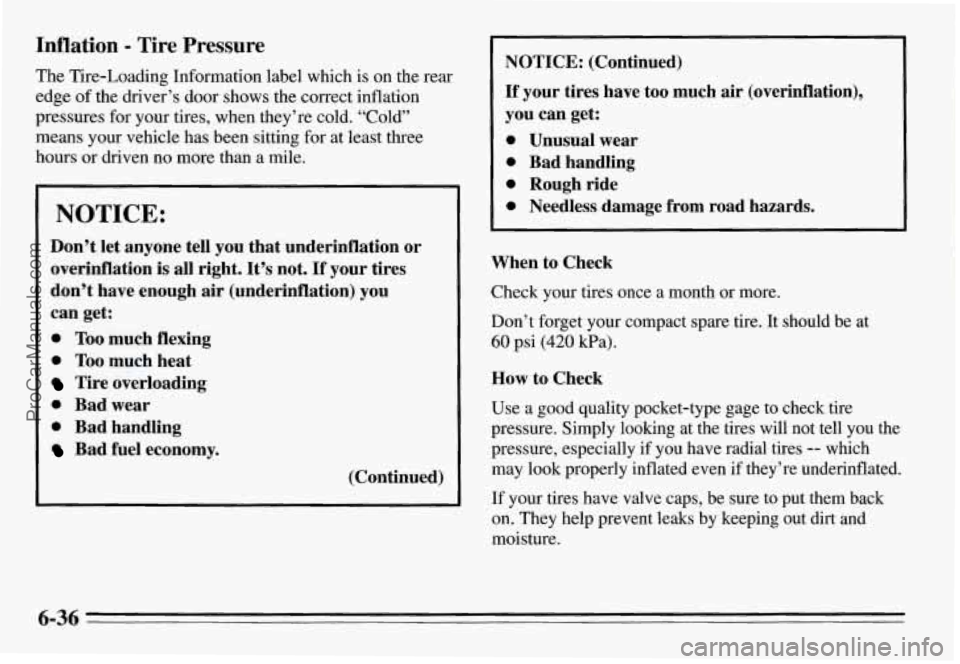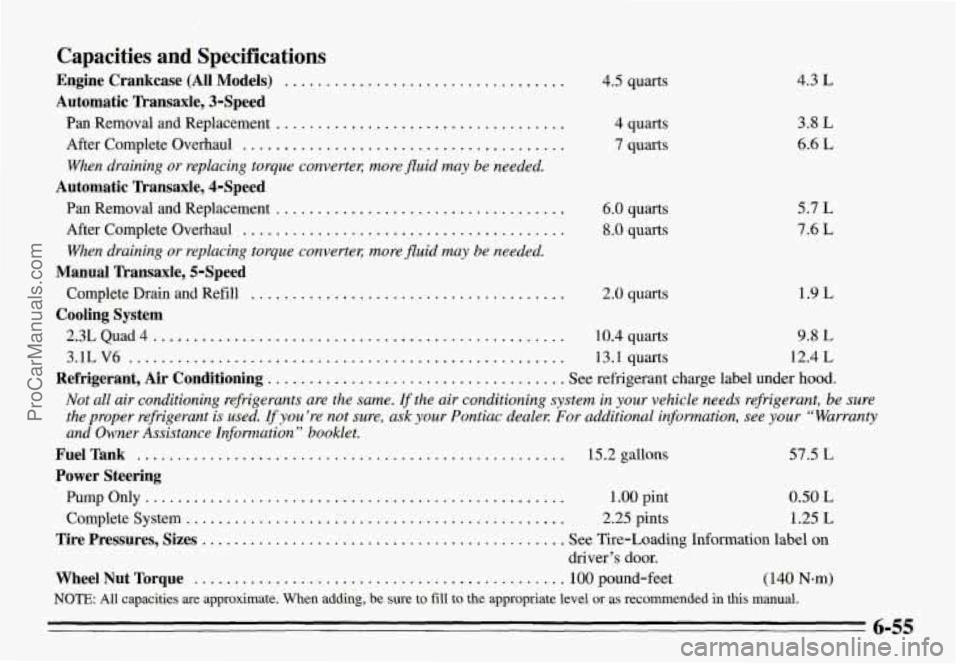1995 PONTIAC GRAND-AM fuel
[x] Cancel search: fuelPage 247 of 354

Inflation - Tire Pressure
The Tire-Loading Information label which is on the rear
edge of the driver’s door shows the correct inflation
pressures for your tires, when they’re cold. “Cold”
means your vehicle has been sitting for at least three
hours or driven no more than a mile.
I NOTICE:
Don’t let anyone tell you that underinflation or
overinflation
is all right. It’s not. If your tires
don’t have enough
air (underinflation) you
can get:
0 Too much flexing
0 Too much heat
Tire overloading
0 Bad wear
0 Bad handling
Bad fuel economy.
(Continued)
1 NOTICE: (Continued)
If your tires have too much air (overinflation),
you can get:
0 Unusual wear
0 Bad handling
0 Rough ride
0 Needless damage from road hazards.
When to Check
Check your tires once a month or more.
Don’t forget your compact spare tire. It should be at
60 psi (420 Wa).
How to Check
Use a good quality pocket-type gage to check tire
pressure. Simply looking at the tires will not tell you the
pressure, especially if you have radial tires
-- which
may look properly inflated even if they’re underinflated.
If your tires have valve caps, be sure to put them back
on. They help prevent leaks by keeping out dirt and
moisture.
6-36
ProCarManuals.com
Page 260 of 354

Tires
To clean your tires, use a stiff brush with a tire cleaner.
When applying a tire dressing always take care to wipe
off any overspray or splash from painted surfaces.
Petroleum-based products may damage the paint finish.
Sheet Metal Damage
If your vehicle is damaged and requires sheet metal
repair or replacement, make sure the body repair shop
applies anti-corrosion material to the parts repaired or
replaced to restore corrosion protection.
Finish Damage
Any stone chips, fractures or deep scratches in the finish
should be repaired right away. Bare metal will corrode
quickly and may develop into a major repair expense.
Minor chips and scratches can be repaired with touch-up
materials available from your dealer or other service
outlets. Larger areas of finish damage can be corrected
in your dealer’s body and paint shop.
Underbody Maintenance
Chemicals used for ice and snow removal and dust
control can collect on the underbody. If these are not
removed, accelerated corrosion (rust) can occur on the
underbody parts such as fuel lines, frame, floor pan, and
exhaust system even though they have corrosion
protection.
At least every spring, flush these materials from the
underbody with plain water. Clean any areas where mud
and other debris can collect. Dirt packed in closed areas
of the frame should be loosened before being flushed.
Your dealer or an underbody vehicle washing system
can do this for you.
Chemical Paint Spotting
Some weather and atmospheric conditions can create a
chemical fallout. Airborne pollutants can fall upon and
attack painted surfaces on your vehicle. This damage
can take two forms: blotchy, ringlet-shaped
discolorations, and small irregular dark spots etched into
the paint surface.
Although no defect in the paint job causes this, Pontiac
will repair, at no charge to the owner, the surfaces
of
new vehicles damaged by this fallout condition within
12 months or 12,000 miles (20 000 km) of purchase,
whichever comes first.
6-49
ProCarManuals.com
Page 264 of 354

I Fuse
PRNDL
F/P INJ
STOP
HAZ
CTSY
AIR BAG
- CIRCUIT PWR WDO
BREAKER
PWR ACC
BREAKER - CIRCUIT
Circuitry
Electronic PRNDL Display (Automatic Trans-
axle only)
Fuel Pump, Injectors
Stop/Hazard Lamps
Door Locks, Power Mirrors, Cigar Lighter
Sumlemental Inflatable Restraint
Fuse - ~~
INST LPS
GAUGES
HORN
ALARM
HTR-A/C
RDO
TURN
DR LK
TAIL LPS
WDO
WIPER
ERLS
DR UNLK
FTP
ACC
AIR BAG
PCM
CRUISE
HDLP
Circuitry
Interior Lamps Dimming
Gauges, Warning Lights, Rear Defog
Horns, Fog Lamps
Interior Lamps, Chime,
Auto Door Locks, Re-
mote Keyless Entry
Heater,
Air Conditioning, Anti-Lock Brakes,
Daytime Running Lamps (Canada)
Radio Power
Turn Signal Lamps
Auto Door Locks
Tail Lamps, Marker Lamps, License Lamp
Power Windows
Windshield Wipers/Washers
Engine Controls, Back-up Lamps
Auto Door Unlock (Remove to Disable)
Flash-to-pass
(U.S.)
Rear Window Defogger, Power Seats, Power
Sunroof (Circuit Breaker)
Supplemental Inflatable Restraint
Powertrain Control Module, Ignition System
Cruise Control
Headlamps (Circuit Breaker)
6-53
ProCarManuals.com
Page 266 of 354

Capacities and Specifications
Engine Crankcase (All Models) ..................................
Automatic Transaxle, 3-Speed
Pan Removal and Replacement ...................................
When draining or replacing torque convertel; more fluid may be needed.
Pan Removal and Replacement ...................................
When draining or replacing torque convertel; more fluid may be needed.
After Complete Overhaul .......................................
Automatic Transaxle, 4-Speed
After Complete Overhaul .......................................
Manual Transaxle, 5-Speed
Cooling System
Complete Drain and Refill ......................................
2.3LQuad4 ..................................................
3.1LV6 .....................................................
4.5 quarts
4 quarts
7 quarts
6.0 quarts
8.0 quarts
2.0 quarts
4.3 L
3.8 L
6.6 L
5.7 L
7.6 L
1.9 L
10.4 quarts 9.8 L
13.1 quarts 12.4 L
Refrigerant, Air Conditioning .................................... See refrigerant charge label under hood.
Not all air conditioning refrigerants are the same. If the air conditioning system in your vehicle needs refrigerant, be sure
the proper refi-igerant is used.
If you’re not sure, ask your Pontiac dealel: For additional information, see your “Warranty
and Owner Assistance Information
” booklet.
FuelTank .................................................... 15.2gallons 57.5 L
Power Steering
Pumponly ................................................... 1.00 pint 0.50 L
Complete System .............................................. 2.25 pints 1.25 L
Tire Pressures, Sizes ............................................ See Tire-Loading Information label on
driver’s door.
WheelNutTorque ............................................. 100pound-feet (140 N-m)
NOTE: All capacities are approximate. When adding, be sure to fill to the appropriate level or as recommended in this manual.
6-55
ProCarManuals.com
Page 271 of 354

How This Section is Organized
The remainder of this section is divided into five parts:
“Part A: Scheduled Maintenance Services” shows
what
to have done and how often. Some of these
services can be complex,
so unless you are technically
qualified and have the necessary equipment,
you should
let your dealer’s service department or another qualified
service center do these jobs.
If you are skilled enough to do some work on your
vehicle, you will probably want to get the service
information
GM publishes. See “Service Publications”
in the Index.
“Part B: Owner Checks and Services” tells you what
should be checked whenever you stop for fuel. It also
explains what you can easily do to help keep your
vehicle in good condition.
“Part C: Periodic Maintenance Inspections” explains
important inspections that your Pontiac dealer’s service
department or another qualified service center should
perform.
“Part D: Recommended Fluids and Lubricants” lists
some products
GM recommends to help keep your
vehicle properly maintained. These products, or their
equivalents, should be used whether you do the work
yourself or have it done.
“Part E: Maintenance Record” provides a place for
you to record the maintenance performed on your
vehicle. Whenever any maintenance is performed, be
sure to write it down in this part. This will help you
determine when your next maintenance should be done.
In addition, it is a good idea to keep your maintenance
receipts. They may be needed to qualify your vehicle for
warranty repairs.
7-2
ProCarManuals.com
Page 272 of 354

Part A: Scheduled Maintenance
Services
Using Your Maintenance Schedule
We at General Motors want to help you keep your
vehicle in good working condition. But we don’t
know
exactly how you’ll drive it. You may drive very short
distances only a few times a week. Or you may drive
long distances all the time in very hot, dusty weather.
You may use your vehicle in making deliveries. Or you
may drive it to work, to do errands or
in many other
ways.
Because of all the different ways people use their GM
vehicles, maintenance needs vary. You may even need
more frequent checks
and replacements than you’ll find
in the schedules in this section.
So please read this
section and note how you drive. If you have any
questions on how to keep your vehicle in good
condition, see your Pontiac dealer.
This part tells you the maintenance services you should
have done and when you should schedule them.
If you
go to your dealer for your service needs, you’ll know
that GM-trained and supported service people will
perform the work using genuine GM parts.
The proper fluids and lubricants to use are listed in Part
D. Make sure whoever services your vehicle uses these.
All parts should be replaced and all necessary repairs
done before you
or anyone else drives the vehicle.
These schedules are for vehicles that:
e
e
e
carry passengers and cargo within recommended
limits. You will find these limits on
your vehicle’s
Tire-Loading Information label. See “Loading Your
Vehicle” in the Index.
are driven on reasonable road surfaces within legal
driving limits.
use the recommended unleaded fuel. See “Fuel” in
the Index.
Selecting the Right Schedule
First you’ll need to decide which of the two schedules is
right for your vehicle. Here’s how to decide which
schedule to follow:
7-3
ProCarManuals.com
Page 273 of 354

Maintenance Schedule
Schedule I Definition
Follow Maintenance Schedule I if any one of these is
true
for your vehicle:
Most trips are less than 5 to 10 miles (8 to 16 km).
This is particularly important when outside
temperatures are below freezing.
Most trips include extensive idling (such as frequent
driving in stop and go traffic).
Most trips are through dusty areas.
0 You frequently tow a trailer or use a carrier on top of
your car. (With some models, you should never tow a
trailer. See “Towing a Trailer” in the Index.)
S’chedule
I should also be followed if the vehicle is used for
delivery service, police,
taxi, or other commercial application.
Schedule I Intervals
Every 3,000 Miles (5 000 km) or 3 Months,
Whichever Occurs First
Every
6,000 Miles (10 000 km) or 6 months,
Whichever Occurs First
Chassis Lubrication
Engine Oil and Filter Change
Schedule I Intervals
At 6,000 Miles (10 000 km) - Then Every
12,000 Miles
(25 000 km)
Every 15,000 Miles (25
000 km)
Tire Rotation
Air Cleaner Filter Inspection, if driving in dusty
conditions
Every 30,000 Miles (50 000 km)
Air Cleaner Filter Replacement Spark Plug Replacement (except 2.3L Code
D
Spark Plug Wire Inspection (except 2.3L Code D
Fuel Tank, Cap and Lines Inspection
Engine Accessory Drive Belt Inspection (or every 24 months, whichever occurs first)
Cooling System Service (or every 24 months, whichever occurs first)
Every 50,000 Miles (83 000 km)
Every
100,000 Miles (166 000 km)
engine) engine)
Automatic Transaxle Service (severe conditions only)
Spark Plug Replacement (2.3L Code
D engine only)
7-4
ProCarManuals.com
Page 274 of 354

Maintenance Schedule
Schedule I1 Definition I
Follow Schedule I1 ordy if none of the conditions from
Schedule
T is true.
I Schedule I1 Intervals I
Every 7,500 Miles (12 500 km)
whichever occurs first)
occurs first)
Engine Oil and Filter Change (or every 12 months,
Chassis Lubrication (or every
12 months, whichever
At 7,500 Miles (12 500 km) - Then Every
15,000 Miles
(25 000 km)
Tire Rotation
Every 30,000 Miles (50 000 km)
Engine Accessory Drive Belt Inspection (or every
Cooling System Service (or every
24 months,
Spark Plug Replacement (except
2.3L Code D
Spark Plug Wire Inspection (except 2.3L Code D
Air Cleaner Filter Replacement
Fuel Tank, Cap and Lines Inspection
24 months, whichever occurs first)
whichever occurs first)
engine)
engine)
Every 50,000 Miles (83 000 km)
Automatic Transaxle Service (severe conditions only)
Every 100,000 Miles (166 000 km)
Spark Plug Replacement (2.3L Code D engine only)
7-5
ProCarManuals.com